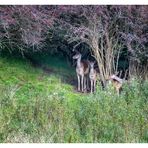Fallow Deer fleeing
09/23/2022
When I arrived at the location of the fallow deer from the previous day, I found the pack with their fawns again today, as they are loyal to their location. I was lucky. I was standing at exactly the same distance from them as the day before, about 160 meters away, with a depression between us. They showed no fear, but some of the animals changed their location after a while. Despite the great distance, they were probably startled a little by a light reflection on the optics of the telephoto lens, as they are hunted in this area.
"The fallow deer had become extinct in Central Europe until the Romans reintroduced it as a sacrificial animal around 2,000 years ago. In the Middle Ages, it was a treasure of the nobility. The white-spotted summer coat and the shovel-like antlers of the deer are typical. Otherwise, their behavior is similar to that of red deer, although they are weaker in build. Lower demands than red deer allow fallow deer to be kept in enclosures. When fleeing, the hopping jumps with the tail stretched out straight are characteristic."
"Ruminants are escape animals. Their bodies are perfectly adapted to detect predators in short time and escape from them quickly. The deer slips into the nearest thicket as quickly as possible, chamois and ibex climb into nearby rocks, while the stag flees over greater distances. Ruminants have extremely powerful senses (hearing, smell and sight) for detecting predators. They can precisely localize sounds thanks to their ears that can move in all directions. They can smell enemies from great distances, and their eyes, which are located on the sides, enable them to see almost all around. They notice movements particularly well."

Fallow deer hiding in a bush
Manuel Gloger
23.09.2022
Als ich beim Standort der Damhirschkühe vom Vortag ankam, fand ich heute das Rudel erneut mit ihren Kitzen, da sie Standort treu sind. Glück gehabt. Ich stand in exakt der gleichen Entfernung zu ihnen wie am Vortag, etwa 160 Meter entfernt, mit einer Senke zwischen uns. sie zeigten keine Scheu, aber einige Tiere wechselten nach einer Weile ihren Standort. Wahrscheinlich hat sie, trotz der großen Entfernung ein Lichtreflex auf der Optik des Teleobjektives ein wenig aufgeschreckt, da sie ja in dieser Gegend bejagt werden.
"Das Damwild war in Mitteleuropa ausgestorben, bis die Römer es vor etwa 2.000 Jahren wieder als Opfertier einführten. Im Mittelalter war es eine Kostbarkeit des Adels. Typisch sind das weiß gefleckte Sommerkleid und das schaufelartige Geweih der Hirsche. Ansonsten ähneln sie im Verhalten dem Rotwild bei allerdings schwächerem Körperbau. Niedrigere Ansprüche als das Rotwild ermöglichen eine Gehegehaltung des Damwilds. Bei der Flucht sind die Hüpfsprünge mit gerade gestrecktem Wedel charakteristisch."
https://waidwissen.com/damwild
"Wiederkäuer sind Fluchttiere. Ihr Körper ist perfekt daran angepasst, Raubfeinde rechtzeitig zu entdecken und ihnen schnell zu entfliehen. Dabei schlüpft das Reh möglichst rasch in die nächste Dickung, Gämse und Steinbock klettern in nahe Felsen, während der Hirsch über grössere Distanzen flüchtet. Zum Feststellen von Raubfeinden besitzen Wiederkäuer extrem leistungsfähige Sinne ( Gehör, Geruch und Sehsinn ). Geräusche können sie dank den in alle Richtungen beweglichen Ohrmuscheln genau lokalisieren. Sie riechen Feinde auf weite Distanzen, und ihre seitlich
liegenden Augen befähigen sie fast zur Rundumsicht. Dabei bemerken sie Bewegungen besonders gut."
https://jageninderschweiz.ch/wp-content/uploads/jageninderschweiz-leseprobe.pdf










Commenti 0
Cancella commento
Eliminare commento e risposte